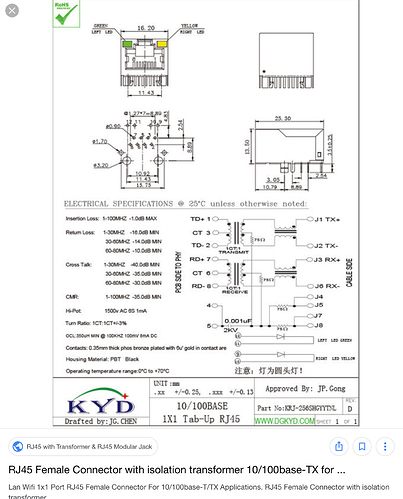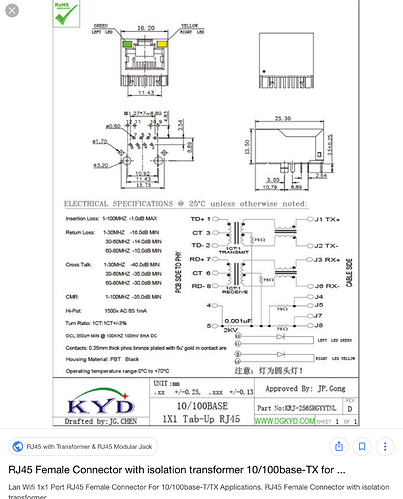I think AMP has it right here: the IEEE Ethernet specification requires transformer isolation so it is unusual for it to be omitted (and then only in applications where it is known that isolation is not needed, such as when Ethernet is used over a backplane within a single chassis). For what it’s worth, I’ve never seen any consumer equipment without the required transformers.
By the way, CANbus is quite different to Ethernet - I’m sure you knew that!
Sorry, this is absolutely incorrect. IEEE802.3 (the Ethernet spec) has very specific requirements for isolation as well as resistance to current and voltage spikes. This is all to maintain performance in variable EMI and RFI scenarios as well as for electrical safety. In order for something to be called Ethernet it has to follow these specs. A while back one of the revisions to the Rasberry Pi left out the transformers by accident and the manufacturer had to recall all of them.
Typical transformers are like these (not an endorsement, just the first thing that popped up in Google):
https://eu.mouser.com/new/halo-electronics/halo-ethernet-transformers/
The packages are small and handle anywhere from one PHY to 12 or 24 depending on the specific design. Open up any product with Ethernet and you’ll find some variant of these. If there’s no transformer it’s not following the spec and is also a potential electrical safety hazard.
The reason I recommend against shielded cables is that they do connect the ground plane of two devices. In the real world (the billions of Ethernet implementations which don’t involve audiophiles) this isn’t an issue as shielded cables are only used in very specific situations (typically within a rack) so the issue of differing electrical potentials is minimized.
Sorry for my bad, I finally found that the isolating transformers are actually integrated inside RJ-45 connector. This is commonly found in router switches, PC and also streamers where LAN connection is used.
I was looking for SMT isolating transformers on the board prior to the transceiver chip, but so far I didn’t found one. It looks something like this…
So essentially LAN connection is indeed galvanic isolated from the transmitter and the receiver.
Thank you @AMP
I know Hans Beekhuyzen spoke highly of the Pink Faun in a youtube review. Depends on how much cash you got I guess, sometimes a cheap solution doesn’t make things better and can make things worse. Can you contact Pink Faun and ask if you can return it if it’s not suitable? Grounding can be beneficial but you’ll have to see what works for you in your system. The Meicord Opal is meant to be a good unshielded ethernet cable- might be worth trying first. I’m looking to mains power conditioning next- Puritan PSM136 for the ground loops on my valve pre-amp and various EMI/RFI issues plus I’ve got DC offset on my mains. But that’s not a cheaper option at all. I’m also going to look at some Meicord because my ethernet port isn’t galvanically isolated on my SOtM 200 Ultra Neo- Hans noticed improvements with the SOtM and Pink Faun. Nice to read @AMP Andrew’s thoughts on unshielded cables, I know shielded vs unshielded is also a debate in itself- good ethernet cables are next on my purchase list but I’ll need three or four cables so I’m trying to weigh up the best option vs cost. Unshielded seems like the way to go as does good grounding. Then there’s ethernet switches…oh the rabbit holes!
Using transformer coupling does not provide complete galvanic isolation. Transformer coupling does a good job of reducing common-mode and normal-mode noise. But, it does not block all noise. High impedance noise does get through. So, other steps are required to eliminate noise than can affect sound quality. In some cases, it is as simple as grounding the negative line of an ungrounded Ethernet switch SMPS.
This is typical RJ-45 female connector found in routers, PC/MAC and streamers that use LAN connection.
Two transformers per phase; one for isolation and the other is for common mode noise rejection. All these can be integrated into a small RJ-45 connector!
I have tried this and it works! The implementation is simple; use two fiber media converters between all your noisy network stuff like routers, NAS, network switches and server and your audio gear. Electrical noise is eliminated on your LAN and cannot get into your audio gear because it is separated by a length of fiber optic cable which does not transmit electrical noise. I also believe I get a better picture from my TV when using internet based programming like Netflix or Prime by eliminating the electrical noise. For $110 it is easy. I did go to the trouble to replace the switching power supply to the media converters to a low noise linear power supply. Here is a link to the project…https://www.audiostream.com/content/electrically-isolate-your-networked-audio#TDc7Sx8W1PfDcWwH.97
They use isolating magnetics aka LAN Ethernet transformers. These are discrete packages and look like chunky ICs.
No. It only makes a difference IF your DAC has inadequate USB isolation. Good DACs these days simply dont require it.
Ethernet by definition is galvanically isolated as mentioned above. There is no need in a domestic installation to use shielded cat6 so its just a non issue.
Thanks, I came to know that RJ-45 connectors that conforms to IEEE 802.3 standard have isolating transformers built-in, they are visible unless you open the RJ-45 connector that is soldered on the board. So they are electrical isolated.
Provided there a USB isolation built-in. If not user can still invest on USB isolator.
Some isolation can be better than no isolation.
But just seeing “galvanically isolated input” on the marketing material doesn’t mean all problems are solved…
Not all USB isolation methods are created equal…
"Just because someone puts in a digital isolator doesn’t mean they have isolated an input. Even if they also provide isolated power to the USB processing doesn’t mean the have isolated an input. Digital isolators come in many forms and most actually have problems of their own (e.g. high rate clocks internally, too much capacitance allowing high frequency noise to pass right thru or adding gobs of jitter.) Remember digital isolators aren’t normally built to keep noise out, they are designed to keep large voltages out, something entirely different. In the DS and many DACs there’s precious little jitter or noise in the data after the USB is processed, but merely having a USB signal coming into the box radiates noise thruout the DAC - i.e. it’s not necessarily an isolation problem that isolation chips are designed to help. Not that I’m saying doing good isolation is a bad thing, but (like most things in audio) it’s not a panacea."
Not completely.
I’ve tried this and it sounds great.
Too expensive so I use Holo Audio Titanis instead.
https://kitsunehifi.com/product/holo-audio-titanis-active-usb-processor/
Jeff Zhu told me that Holo Spring DAC is galvanic isolated on its USB input.
Any ideas why it is not complete? Transformers coupling provides isolation, in the case of IEEE 802.3 standard up to 1.5kV.
Not sure what you mean. Can you elaborate?
The Ethernet specification, as already stated above, requires isolation using transformer coupling. The reason for this is because communication lines often cover long distances and the ends can be powered from different parts of a power distribution network. This can result in significant ground offset between network nodes.
The upshot is a differential circuit, i.e. the transformer only sees the voltage across the windings. This solution also has good common mode rejection. That is, the ability to reject noise.
Unfortunately, I don’t see that this is relevant to the discussion. The linked article relates to switch mode power supplies and specifically bonding DC- to ground. Something I wouldn’t recommend.
Martin, Martin, Martin…
John Swenson designs power supplies and other electronic devices for a living. I think his advice is probably more solid than what you might think is recommended or not.
Also, one of the points of that thread is that Ethernet transformers do not block all noise and that is what I have been saying here all along. Ethernet transformers are not the be all end all in noise blocking over UTP…

